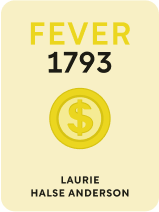

This article is an excerpt from the Shortform book guide to "Fever 1793" by Laurie Halse Anderson. Shortform has the world's best summaries and analyses of books you should be reading.
Like this article? Sign up for a free trial here .
Who is Collette in Fever 1793? Why is it significant that the Ogilvie family was affected by yellow fever?
In Fever 1793, Collette Ogilvie is the daughter of Pernilla Ogilvie and she becomes ill with yellow fever. Collette getting sick proved that the fever was not just something low-class citizens got and many rich people fled Philadelphia soon after.
Keep reading to learn about Collette Ogilvie’s family and how she got sick.
Tea at Collette Ogilvie’s House
This article explains who Collette in Fever 1793 is and shows how yellow fever did not discriminate regarding social class.
Despite the rising number of deaths, things didn’t change much around the coffeehouse. Seven days later, Matilda and Grandpa were out in the backyard joking around like any other day. He relaxed in the shade while she pushed clean linens through the mangler in the scorching heat. They talked about the weather. Matilda longed for winter days and skating on the frozen river. Grandpa liked the heat; the cold made his bones ache.
Grandpa scoffed at the fever panic. August fevers were normal, he said. He blamed the refugees and suggested they be quarantined on an island until the fever passed. Lucille again brought up going to the Ludingtons’ until the fever blew over. Grandpa was about to argue, but he was interrupted when a note arrived at the door. Pernilla Ogilvie, the matriarch of a prominent family, was inviting Matilda and Lucille for tea that afternoon. The Ogilvies had five sons, and Lucille had her eye on the youngest, Edward, as Matilda’s future husband.
Matilda protested. She refused to go until Grandpa reminded her that her choices were either tea or chores. Lucille jumped into action to find them something to wear. They didn’t have tea-drinking clothes, and Matilda had grown out of the one nice dress she had. Lucille only had an outdated banquet dress from after the war. With such short notice, they had to make do with what they had. Eliza combed the knots from Matilda’s hair, a chunk of which was stuck together with jam.
When they were finished primping, Matilda looked like a doll. She was mortified. She said she would be polite, but she wasn’t going to talk to Edward. She didn’t need a husband to run the coffeehouse. Her mother was proof of that.
Lucille said she’d be lucky if an upstanding gentleman like Edward agreed to marry an ill-mannered girl like her. With four older brothers, Edward’s prospects were small enough that Matilda would barely be acceptable as the daughter of a successful business owner. She would get married and be happy. The last thing they all needed was another spinster in the house.
Across the Class Divide
Matilda was stuffed into her bodice and petticoat so tightly, she could barely breathe. Lucille promised they wouldn’t stay long after knocking on the Ogilvies’ door. They had to get back before Grandpa gave the shop away. Then, she turned to Matilda, and with uncharacteristic gentleness, she said that Matilda was going to grow into a beautiful woman. She wanted the best life for Matilda that she could have. Matilda was taken aback by Lucille’s intimacy and compassion. But as quickly as it appeared, it vanished. The door opened, and they were let in.
The inside of the Ogilvie home was enormous and extravagant—crystal chandeliers, a large mahogany table, and Chippendale chairs. Pernilla Ogilvie waltzed out in a lavish gown and dusted hair. The two daughters, Colette and Jeannine, were summoned with a bell. They appeared dressed identically in pink and yellow gowns. Both Matilda and Lucille felt naked in their old clothes.
Colette, the oldest, was pale and had dark circles under her eyes. Jeannine, on the other hand, was a vision of health and mischief. It didn’t take long before her snobbery revealed itself during tea. She stuck her tongue out at Matilda behind a silk fan. She moved the plate of pastries out of Matilda’s reach.
Pernilla was no better. As soon as she was introduced to Matilda, she commented on how sad it was that Matilda’s handsome father had died. If he’d only been educated, he could have made something of himself. The Cook women bristled, but Lucille was determined not to spoil the conversation.
Pernilla lamented about the fever, too. She complained that all of her society friends had fled to the country. She was bored and distraught that her gala to celebrate Colette’s recent engagement was canceled. What an injustice, she said. The filthy refugees and river rats were always sick with something. And now they were interfering in her social life. She looked to Lucille for agreement, but Lucille changed the subject.
Lucille inquired about the Ogilvie boys. She asked whether any of them were engaged or had considered a career in business. Pernilla feigned ignorance about the motivation behind the question, but Jeannine was happy to jump in and explain. She said Mrs. Cook was trying to marry Matilda off to one of her brothers, and their dirty tavern was part of the deal.
Both Matilda and Lucille jumped to defend their respectable business. However, the conversation halted when Colette stood from the table shaking and sweating. She’d become weaker over the course of tea, spilling cakes on the floor and tea on her dress. The last thing she said before she collapsed was that she was burning. Lucille placed a hand to her forehead. Colette had the fever.

———End of Preview———
Like what you just read? Read the rest of the world's best book summary and analysis of Laurie Halse Anderson's "Fever 1793" at Shortform .
Here's what you'll find in our full Fever 1793 summary :
- What the yellow fever epidemic in 1793 in Philadelphia looked like
- How this epidemic exposed the vulnerability of everyone, including the wealthy
- How an epidemic can impact a young person






